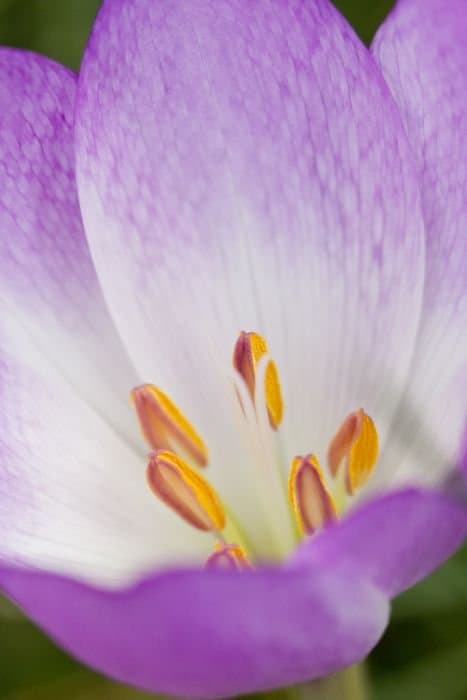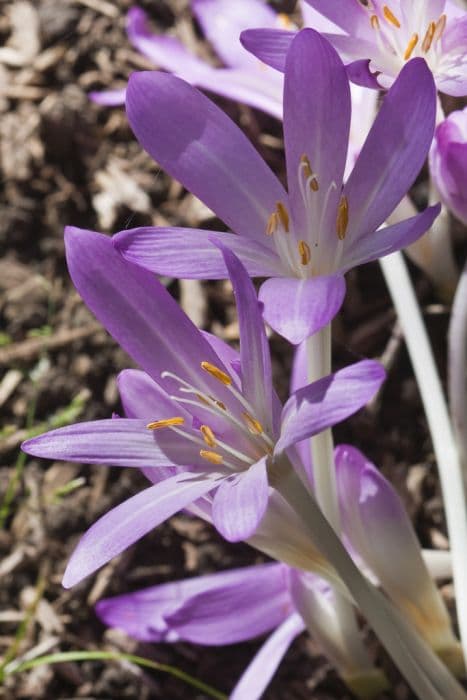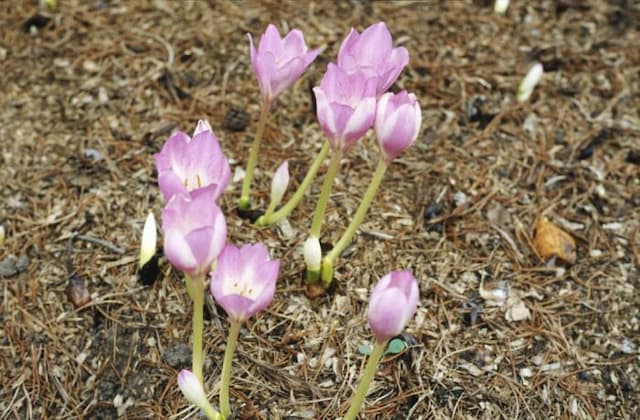Autumn crocus Colchicum speciosum

ABOUT
Commonly known as the autumn crocus, this distinctive plant blooms with striking, large, cup-shaped flowers. The petals display a vivid pink to purple hue and have a delicate, almost gossamer quality. The flowers possess a noticeable contrast through their prominent white throats which lead to a deeper colored base. Each bloom is a singular beauty, emerging from the ground without any accompanying leaves during a flowering period that precedes the foliage's appearance. After the flowering ends, the leaves begin to show themselves, being quite broad and glossy in appearance, adding to the plant's attractiveness before they die away later in the season. The overall impression given by the autumn crocus is one of a bold, yet ephemeral, burst of color in the landscape, providing an eye-catching display in a seasonal transition period.
About this plant
 Names
NamesFamily
Colchicaceae.
Synonyms
Giant Meadow Saffron, Showy Colchicum, Speciosum.
Common names
Colchicum szovitsii, Colchicum speciosum var. szovitsii, Colchicum speciosum subsp. szovitsii, Colchicum autumnale var. speciosum, Colchicum luteum, Colchicum kesselringii, Colchicum speciosum var. bornmuelleri.
 Toxicity
ToxicityTo humans
The most common common name for Colchicum speciosum is Autumn Crocus. All parts of the Autumn Crocus plant are highly poisonous to humans due to the presence of colchicine, which is a potent alkaloid. Ingestion can lead to severe gastrointestinal distress, including symptoms such as nausea, vomiting, diarrhea, and abdominal pain. Large ingestions can result in kidney failure, respiratory failure, and multiple organ dysfunction, which can be fatal. Medical attention should be sought immediately if ingestion is suspected.
To pets
In pets, the Autumn Crocus is similarly toxic as it is to humans. The toxic compound colchicine affects cats, dogs, and horses, among other animals. Symptoms of poisoning in pets include drooling, vomiting, diarrhea, abdominal pain, severe gastrointestinal upset, seizures, and respiratory failure. As in humans, ingestion can lead to multiple organ failure and can be potentially fatal. Immediate veterinary care is crucial if a pet ingests any part of this plant.
 Characteristics
CharacteristicsLife cycle
Perennials
Foliage type
Deciduous
Color of leaves
Green
Flower color
Pink
Height
6 inches (15 cm)
Spread
3 inches (7.5 cm)
Plant type
Bulb
Hardiness zones
4
Native area
Middle East
Benefits
 General Benefits
General Benefits- Landscape beautification: Colchicum speciosum, commonly known as the autumn crocus, produces vibrant and attractive purple flowers that enhance the aesthetic appeal of gardens and landscapes.
- Pollinator attraction: The autumn crocus attracts bees and other pollinators, supporting local ecosystems and biodiversity.
- Seasonal interest: Blooming in the fall, the autumn crocus provides color and interest in gardens at a time when many other plants have finished flowering.
- Low maintenance: This plant is relatively easy to care for, requiring minimal maintenance once established, making it suitable for novice gardeners.
- Naturalizing: The autumn crocus can spread and naturalize in suitable conditions, creating drifts of color without the need for constant replanting.
 Medical Properties
Medical Properties- Antigout - Colchicum speciosum, commonly known as autumn crocus, contains compounds that are used to treat gout by decreasing inflammation and reducing the deposition of uric acid crystals in the joints.
- Anti-inflammatory - The alkaloids present in Colchicum speciosum may possess anti-inflammatory properties.
- Cytotoxic - Some studies suggest that certain alkaloids extracted from Colchicum speciosum may have cytotoxic effects and could potentially have applications in cancer treatment.
- Analgesic - Colchicum speciosum has been used in traditional medicine for its pain-relieving properties.
 Air-purifying Qualities
Air-purifying QualitiesThis plant is not specifically known for air purifying qualities.
 Other Uses
Other Uses- Garden Ornamentation: Colchicum speciosum, commonly known as autumn crocus, is often used in gardens for its showy, vibrant purple flowers that bloom in the autumn, providing color when many other plants are fading.
- Bee Attraction: The autumn crocus can serve as a source of nectar for bees in early fall, thereby supporting local bee populations.
- Photography Subject: Due to its striking appearance, the autumn crocus is a popular subject for photographers, particularly those specializing in botanical and nature photography.
- Educational Tool: Botany educators may use Colchicum speciosum to teach students about plant biology, specifically bulbous plant structures and life cycles.
- Botanical Art: Artists may utilize the unique shape and color of the autumn crocus in watercolor paintings, drawings, and other forms of botanical art.
- Theme Gardens: This plant is suitable for inclusion in a 'fall interest' or 'seasons' themed garden, where the goal is to highlight seasonal changes and plant species that peak at different times of the year.
- Cultural Symbol: In some cultures, Colchicum speciosum may be used in art and literature as a symbol of the transition from summer to fall or as a metaphor for changes and endings due to its autumnal blooming.
- Alpine Gardening: Because the autumn crocus naturally grows in mountainous regions, it can be used in rock or alpine gardens that aim to replicate such highland environments.
- Companion Planting: Gardeners may plant autumn crocus alongside late-blooming companion plants to create a succession of blooms that extend the visual appeal of their gardens into the late season.
- Floral Arrangements: Although not a traditional cut flower due to its toxicity and short lifespan once cut, Colchicum speciosum can be used in live floral arrangements where the bulbs are planted in a container.
Interesting Facts
 Feng Shui
Feng ShuiThe Autumn Crocus is not used in Feng Shui practice.
 Zodiac Sign Compitability
Zodiac Sign CompitabilityThe Autumn Crocus is not used in astrology practice.
 Plant Symbolism
Plant Symbolism- Beauty: Colchicum speciosum, commonly known as the Autumn Crocus, is known for its beautiful, large purple flowers that bloom in fall, symbolizing the appreciation of natural beauty.
- Resilience: As a flower that blooms boldly near the end of the growing season, the Autumn Crocus represents resilience and the ability to thrive in adverse conditions.
- Surprise: The sudden appearance of its blossoms without warning is often symbolic of surprise and unexpected joy.
- Fleeting Nature of Life: The brief lifespan of the flowers, which fade quickly, can symbolize the transient nature of life and beauty.
- Caution: It's also associated with caution due to its toxic nature, reminding us that not all that is beautiful is harmless.
 Water
WaterAutumn Crocus should be watered deeply once a week to keep the soil consistently moist during its active growth in the fall. It is important not to overwater as this can lead to bulb rot. Give the plant about 1 inch of water each week, which translates to about 0.6 gallons for a small garden area of around ten square feet. Once the plant enters its dormant phase in summer, watering should be reduced to very light or none at all, depending on the natural rainfall.
 Light
LightAutumn Crocus thrives best in partial shade to full sunlight. The ideal spot for this plant is one where it receives morning sunlight and is shaded from the more intense afternoon sun. The plant performs well under a light canopy of trees or in a garden bed that receives dappled sunlight throughout the day but avoids deep, full shade locations as this can hinder flowering.
 Temperature
TemperatureAutumn Crocus tolerates a wide range of temperatures but prefers a temperate climate. The plant can survive in temperatures as low as 20°F and as high as 80°F, but it thrives best when daytime temperatures are between 60°F and 70°F. These moderate temperatures during its growth period in the fall are ideal, as the cooler weather aligns with its natural blooming cycle.
 Pruning
PruningPruning Autumn Crocus often entails the removal of spent flowers and yellowing foliage after blooming to keep the plant looking tidy and to prevent potential disease. This should be done yearly, following the plant's flowering period in the fall. There is no need for extensive pruning, but cutting back the foliage at the end of its growing season is sufficient.
 Cleaning
CleaningAs needed
 Soil
SoilAutumn Crocus thrives in well-draining soil with a pH of 6.0 to 7.0. The best soil mix consists of equal parts garden soil, sand, and peat or compost to ensure rich nutrients and adequate drainage. It's important to avoid waterlogging as this can cause bulbs to rot.
 Repotting
RepottingAutumn Crocus bulbs should be repotted every 3 to 4 years or when they become overcrowded. It's best to repot them after they have finished flowering and are dormant, usually in the summer months before they begin to sprout again in the autumn.
 Humidity & Misting
Humidity & MistingAutumn Crocus prefers moderate humidity levels. It does not require high humidity and can tolerate the typical humidity levels found in most homes or gardens. Ensuring good air circulation can help prevent mold and fungal diseases.
 Suitable locations
Suitable locationsIndoor
Provide bright, indirect light and keep in cool room for Autumn Crocus.
Outdoor
Plant in partial shade and well-draining soil for Autumn Crocus.
Hardiness zone
4-9 USDA
 Life cycle
Life cycleColchicum speciosum, commonly known as Autumn Crocus, begins its life cycle as a seed, typically germinating in spring under favorable soil and temperature conditions. Once germinated, it develops a corm, which is a storage organ that helps the plant sustain itself through adverse conditions. During spring and summer, the corm grows and accumulates resources. In late summer to early autumn, the plant produces striking, purple, goblet-shaped flowers directly from the corm, without any foliage present. After flowering, leafy shoots emerge and photosynthesize to gather energy, which is stored in the corm before the leaves die back in early summer. The corm remains dormant underground during the heat of summer, and the cycle restarts with flowering in the autumn.
 Propogation
PropogationPropogation time
Late summer to autumn
The most popular method of propagating Colchicum speciosum, commonly known as the Showy Colchicum, is through its corms. This is generally done in the summer when the plant is dormant. To propagate, carefully dig up the corms and separate the offsets from the parent corm. The offsets, which are smaller corms formed at the base of the parent corm, can be replanted immediately. Each offset should be planted around 2 to 4 inches (5 to 10 centimeters) deep, spaced about 6 inches (15 centimeters) apart to allow enough room for growth. It is important to ensure the soil is well-drained but remains moist, as Showy Colchicum prefers these conditions. With appropriate care, these offsets will develop into flowering plants within one or two growing seasons.








